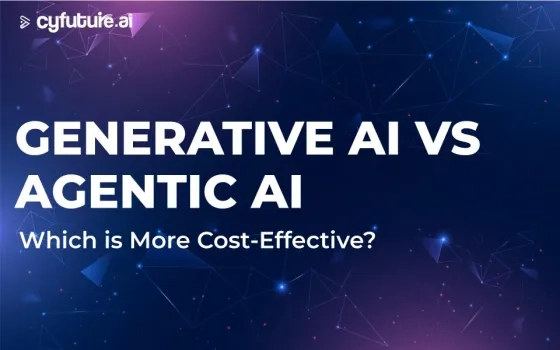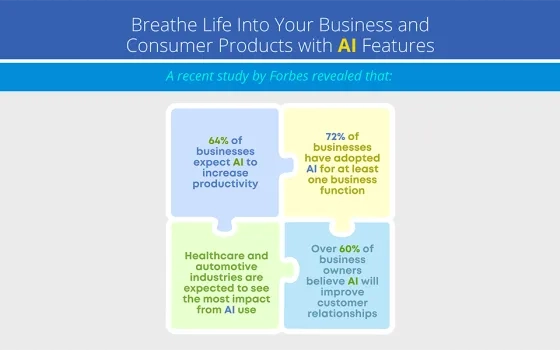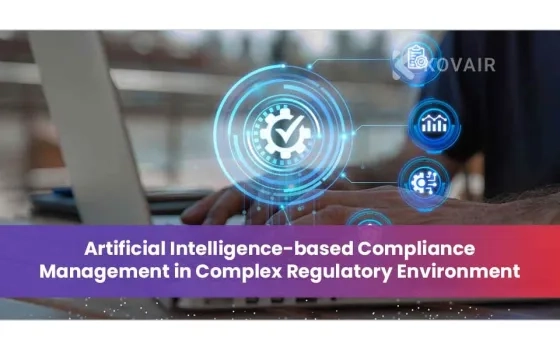Netflix saved $1 billion through strategic AI adoption for its recommendation engine.
And it is not the only company reaping the benefits of AI. Check out this illustrious list -
- Facebook leverages AI to revolutionize user experience.
- Amazon uses AI to personalize product suggestions.
- Tesla integrates AI-powered features like autonomous driving capabilities in its vehicles.
79% of companies recorded significant cost savings with AI implementation. (reference: mckinsey)
AI adoption means using AI tools to enhance efficiency, automate tasks, and aid decision-making. In today's tech-driven market, 9 out of 10 organizations recognize AI's competitive edge (reference: authorityhacker). However, the road to AI entails challenges like -

AI adoption can boost business performance by up to 40%, yet only 35% of businesses have adopted AI (reference: authorityhacker). This is because successful AI implementation demands a tailored and tested strategy. It shall meet your unique business needs whilst mitigating any potential risks.
Notable AI/ML failures like IBM's $62 million investment in the flawed cancer diagnosis system "Watson" or Microsoft's discontinued chatbot "Tay" emphasize the critical need for a foolproof strategy.
10 Steps To Frame Your AI Adoption Strategy
To ensure successful AI implementation, organizations must prioritize a well-defined AI adoption strategy that addresses current business problems and considers futuristic possibilities.
Here are ten foundational steps for successful AI integration:
1. Understand AI Fundamentals
Microsoft launched a chatbot ‘Tay’ equipped to evolve using machine learning techniques. However, when users posted offensive and racist comments, the bot started using the same language. This compelled Microsoft to abort the project abruptly.
Many companies make the mistake of jumping into the AI bandwagon without comprehensively understanding its capabilities and limitations. So, before investing in AI, ensure you know AI fundamentals -
-
What functionalities does AI offer?
-
What is the underlying mechanism of AI operation?
-
How can AI bring innovation and competitive advantage to your industry?
-
Can you customize the tool to align with your specific business goals?
-
What are the risks of integrating AI?
-
What are the limitations of AI?
Understanding these fundamentals can help organizations plan intelligent strategies for smooth AI adoption.
2. Evaluate AI Readiness
Despite the buzz around AI, organizations are lacking a strategic approach. Their technical capabilities, infrastructure, data, and workforce aren't ready for AI integration. Thus, organizations must ensure AI readiness before jumping on the AI bandwagon.
Here are some crucial questions:
-
Is your current infrastructure capable of supporting AI implementation?
-
Do you have enough high-quality data for training AI models?
-
Do you have skilled professionals to implement AI solutions?
-
Can AI integrate into your current systems and workflows?
-
How will your employees and stakeholders react to AI adoption?
This thorough evaluation will guide your decisions and assist in resource allocation. Having a detailed roadmap also helps in addressing barriers to effective AI adoptions.
3. Analyze Your Business Problems
AI is more than a fancy tool, it must address one or more crucial business problems. This could be streamlining internal procedures, improving customer experience or exploring new opportunities. So, you must define clear objectives and align AI initiatives with your business strategies. Collaborate with relevant stakeholders, brainstorm AI use cases, and identify business pain points.
Here are some questions that leaders must ask to identify their business problems:
-
What specific business challenges and pain points can AI address?
-
How can AI contribute to your overall business goals and objectives?
-
Can AI enhance user experience and satisfaction?
-
Can AI improve your internal business processes?
-
What is the probable ROI?
This targeted approach, aligned with business goals, ensures a strategic and effective integration, maximizing AI's transformative potential.
4. Reflect on Leadership and Cultural Dynamics
Successful AI integration hinges on organizational culture and leadership commitment. Leaders must understand AI's benefits, risks, investments, and ROI. They must also maintain transparent communication with the workforce at all stages of AI implementation.
Here, it's important to emphasize that AI complements, not replaces, employees.
Leadership and cultural considerations for seamless AI adoption include -
-
Communicate with your employees to dispel AI fears and misconceptions.
-
Embrace new insights and adapt the strategy with an open mind.
-
Collaborate with AI experts for valuable insights.
-
Instigate a cultural change for data governance.
Driving a cultural shift through open-minded leadership is the cornerstone of successful AI implementation.
5. Foster Networking and Collaboration
AI is evolving at a rapid pace. So, just reading blogs and following AI news is not enough if you want to stay ahead of the game. Build a robust AI network that caters to your industry. Reach out to AI experts and top vendors in the industry. Experts who have developed and implemented similar applications to gain a realistic understanding.
Here’s how to build your AI network -
-
Engage with online AI communities catering to your industry.
-
Attend events, meetups, conferences, or workshops on AI.
-
Join mastermind groups, mentorship programs, or peer learning circles.
Collaborating with the right people provides deeper insights into practical AI adoption aspects. Make sure you talk about timeframes, resource needs, and potential pitfalls. Drawing from shared experiences ensures an informed strategy.

6. Engage in Strategic Decision-Making
Strategic decision-making is crucial for guiding organizations through transformation. Legacy systems can hinder AI progress, affecting data access and real-time decision-making.
Here are a few key steps to ensure robust AI adoption:
-
Stay agile, move one step at a time.
-
Select pilot projects, define success criteria, and learn from failures.
-
Align AI objectives with desired business outcomes.
-
Adapt the AI strategy to market shifts and emerging opportunities.
Effective decisions involve choosing suitable AI applications, resource allocation, and navigating ethical considerations. A well-crafted strategy facilitates seamless integration. It minimizes risks and maximizes benefits. Thus positioning the organization for innovation and resilience in evolving technological landscapes.
7. Integrate Ethical Decision-Making
Make AI ethics central to your AI adoption strategy.
Amazon created an AI recruiting tool but abandoned it due to its bias against women. Compass, an AI legal tool, favored white criminals over blacks, contributing to racial disparities.
These cases underscore the need for ethical frameworks, continuous data validation, and bias mitigation in AI systems. Establish a dedicated AI ethics committee that focuses on:
-
Fairness and transparency
-
Data security, privacy, and ethical data sourcing
-
Accountability, responsibility, and social/environmental impact
-
Regulatory compliance
The AI ethics committee will help mitigate these risks early in AI adoption.
8. Innovation and Competition
While optimizing processes can boost profits, staying ahead requires doing things differently. Your AI adoption strategy should be unique and innovative. Following the trend is not enough; you need to set the trend. You must monitor the industry’s developments and peer AI investments for this.
To keep track of your peers, try these strategies:
-
Understand rivals' AI strategies
-
Assess emerging technologies
-
Align AI adoption with strategic planning
Embracing AI means preparing for future innovations to secure a leading market position beyond current technologies.
9. Build Proof of Technology
Implementing AI is a significant investment. So, ask your AI vendor for a Proof of Technology (PoT) before building the tool. The PoT helps confirm solution feasibility. It also assesses compatibility, performance, scalability, and integration with existing systems.
Here are a few steps to develop your PoT –
-
Refine AI use cases by gathering insights. Focus on impactful areas aligned with company goals.
-
Test performance, scalability, and integration in a controlled environment for a smooth transition.
-
Showcase transformations through scenarios. Gain stakeholder support by illustrating AI's specific benefits.
-
Confirm use case relevance before implementation. Test efficiency and customer experience enhancements, aligning with business objectives.
The PoT acts as a roadmap, enabling early adjustments and minimizing risks.
10. Translate Your Vision into Action
To translate your AI vision into reality, having the entire team onboard is essential. Engage your stakeholders and communicate with your employees about AI. Discuss your plan and maintain thorough transparency. Encourage suggestions and openness about AI in your organization. Understand the risks and also the benefits.
Most importantly, prepare your organization for an AI shift. Here are the key strategies that can help transform your AI vision into reality:
-
Seek input from employees, customers, and partners to shape a robust strategy.
-
Upskill your people to promote AI readiness and trust.
-
Ensure high-quality data availability.
-
Gain new insights and be open to refining your plan.
-
Examine your competitors.
This proactive and collaborative approach positions your organization to harness the transformative power of AI.
AI Vendor Checklist
When it comes to your AI adoption strategy, selecting the right AI vendor is the key. The success of your AI project relies on the capability of your vendor. As such, an important question you must answer is, ‘What do you look for in an AI vendor?’
Here’s a comprehensive AI vendor checklist — your go-to navigational guide for choosing the best AI vendor
1. Check Expertise and Experience
Since we are still in the early stages of AI adoption, many vendors are in the pilot phases.
Seek a proven track record of successful AI projects in your industry. Review their client testimonials, case studies, and ratings on sites like Clutch. Assess the impact of their solutions on efficiency, productivity, or customer experiences.
2. Go Through Their Technology Stack
Assess your vendor’s tech stack to check for compatibility with your existing systems.
Examine their choice of programming languages, frameworks, and data capabilities. A vendor with a solid and up-to-date tech stack is best suited for intricate AI/ML projects.
3. Evaluate Data Handling and Privacy Policies
Data forms the core of AI solutions, powering learning in AI tools.
Ensure the vendor adheres to data privacy measures and complies with relevant privacy regulations like GDPR or CCPA. This ensures a secure and ethical approach. In addition to this, clarify data ownership and access rights for control.

4. Talk about Model Development and Customization
Customization is critical for peak performance and accuracy in AI/ML solutions.
Engage in open communication with the vendor’s team. Inquire whether they utilize pre-built models or offer customized solutions. Evaluate their proficiency in fine-tuning models, integrating domain knowledge, and handling complex algorithms.
5. Discuss Deployment and Support Policies
Assess your vendor’s deployment and post-deployment support. Strong technical support ensures seamless integration of AI/ML solutions into your current infrastructure without disruptions.
Assess the vendor support after deployment. Consider maintenance schedules and response times for issue resolution. Seek vendors that adhere to an agile approach. An ideal AI vendor should be open to accommodate changes or upgrades.
6. Assess Collaboration and Communication
A thriving vendor-client relationship relies on effective communication.
Check the vendor's communication channels and responsiveness. Ensure that your AI vendor understands your requirements well. Make sure they provide regular updates and progress reports. Clear communication is critical for shared goals throughout the project.
7. Verify Pricing and Contractual Agreements
Finally, assess the vendor's pricing model and contractual agreements.
Check the licensing fees, implementation costs, and ongoing maintenance charges. Review all the contractual terms and conditions. Read the service-level agreements (SLAs), termination clauses, and intellectual property rights thoroughly. At this stage, you may engage legal experts to protect your interests.
Successful project execution and achieving desired outcomes rely on effective AI vendor management. Evaluate the vendor's offerings, expertise, and pricing to confirm alignment with your AI goals.
Conclusion
AI is reshaping customer service through chatbots, personalizing experiences with recommendation engines, and transforming workflows with AI models. Despite its transformative potential, AI adoption requires a thorough approach involving technology, people, and culture changes.
Critical steps in successful AI adoption include understanding AI fundamentals, assessing readiness, identifying business problems AI can address, considering ethical implications, building proof of technology, and overcoming barriers to change.


















